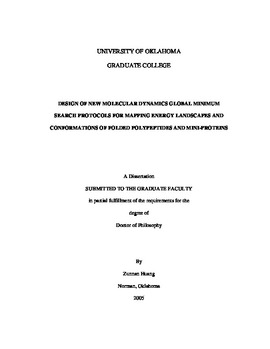| dc.contributor.advisor | Wheeler, Ralph A., | en_US |
| dc.contributor.author | Huang, Zunnan. | en_US |
| dc.date.accessioned | 2013-08-16T12:19:57Z | |
| dc.date.available | 2013-08-16T12:19:57Z | |
| dc.date.issued | 2005 | en_US |
| dc.identifier.uri | https://hdl.handle.net/11244/935 | |
| dc.description.abstract | First, a new MD search strategy called DIvergent Path (DIP) search simulation is developed in which the simulations start with several independent polypeptides having the same initial coordinates and temperatures but different velocity directions, which evolve into different trajectories. The DIP simulations reveal three primary limitations of conventional MD simulations: potential energy traps, free energy traps, and kinetic traps. Among them, kinetic traps are the most limiting factor for MD simulations intended to sample varied conformational space at room temperature. This trap is caused by mechanical equilibrium (when both kinetic and potential energies have reached equilibrium) and can be easily overcome by intervening to reassign atomic velocities and thus randomize simulation trajectories. By combining this trajectory randomization strategy at one temperature with cycles of heating and cooling, the DIsrupted VElocity (DIVE) search simulation is further developed. The DIVE simulations can explore wide ranges of the rugged potential energy surfaces of peptides, sample myriad potential energy minima, and explore diverse conformations even in a very limited simulation time. Finally, a combined procedure is also built in which the global potential energy minimum and myriad local potential energy minima are explored by using DIVE simulations followed by DIP simulations to search for the global free energy minimum near in vivo temperatures. | en_US |
| dc.description.abstract | Molecular dynamics (MD) simulations are widely used for global conformational searches in protein folding. However, conventional canonical ensemble simulations (constant NVT) usually cannot explore biologically active natural structures of proteins because such simulations have extreme difficulty sampling conformational space sufficiently for global energy minimum searches. The work described here delineates the crucial limitations restricting conventional NVT simulations from covering a wide variety of conformations and develops several new MD simulation protocols for efficiently sampling diverse regions of conformational space to search for the global minimum energy structure of polypeptides and mini-proteins. | en_US |
| dc.description.abstract | We performed the new MD simulations for mapping energy landscapes and conformations of a model 13 residues polyalanine peptide Ala13, an amphiphilic octadecapeptide, peptide F, and a 20-residue mini-protein, Trp-cage, using the AMBER force field either in vacuo or in a generalized Born/solvent-accessible surface area (GB/SA) implicit solvent for water. The simulation results are also compared with those from several other simulation algorithms including conventional NVT simulations, the replica exchange method (REM), and locally enhanced sampling (LES) molecular dynamics. Our newly developed MD simulation protocols sample the most diverse region of conformational space and complement existing global geometry optimization techniques for predicting 3D protein structures from only primary sequence data. | en_US |
| dc.format.extent | xxv, 255 leaves : | en_US |
| dc.subject | Molecular dynamics. | en_US |
| dc.subject | Proteins Conformation. | en_US |
| dc.subject | Chemistry, Physical. | en_US |
| dc.title | Design of new molecular dynamics global minimum search protocols for mapping energy landscapes and conformations of folded polypeptides and mini-proteins. | en_US |
| dc.type | Thesis | en_US |
| dc.thesis.degree | Ph.D. | en_US |
| dc.thesis.degreeDiscipline | Department of Chemistry and Biochemistry | en_US |
| dc.note | Adviser: Ralph A. Wheeler. | en_US |
| dc.note | Source: Dissertation Abstracts International, Volume: 66-12, Section: B, page: 6646. | en_US |
| ou.identifier | (UMI)AAI3203295 | en_US |
| ou.group | College of Arts and Sciences::Department of Chemistry and Biochemistry | |
